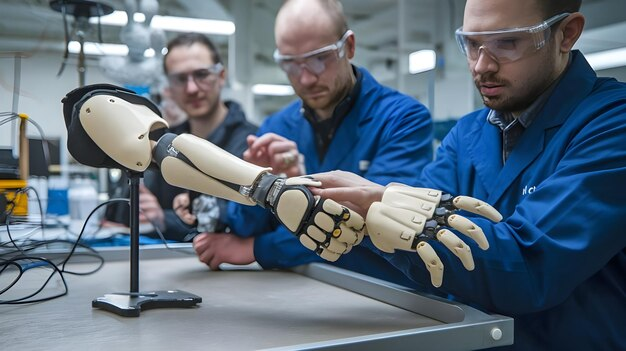
The workplace has changed to support people with different abilities, helping those with limb differences to succeed. Prosthetic arm help employees do tasks well, increasing their confidence and work output. Companies that use supportive technology create welcoming spaces that benefit both workers and businesses.
In this article, we will learn how prosthetic arms help in the workplace by covering their use, benefits and new developments.
The Role of Prosthetic Arms in the Workplace
Modern prosthetic arms restore important functions, allowing users to do detailed tasks. These devices fit different industries, from factories to office jobs. New technology makes sure prosthetic users can use tools, type, and make exact movements. They help employees handle daily tasks with more ease by improving their work performance.
Prosthetic arms allow workers to grip objects, press buttons, and carry items safely. Myoelectric models, which respond to muscle signals, help with detailed movements. Body-powered prosthetics offer strength for lifting and handling heavy tools. Passive prosthetics provide support, assisting with balance and positioning.
Additionally, for individuals with lower limb loss, a Transtibial Prosthesis plays a crucial role in maintaining mobility and workplace accessibility. Employers who accommodate different prosthetic needs create an inclusive environment where all employees can thrive.
Different industries benefit from prosthetic arms. In manufacturing, workers use them to operate machinery and assemble products. Healthcare professionals rely on them for patient care and medical tasks. In office jobs, they help with typing and document handling. In retail and hospitality, employees can serve customers and organise stock efficiently.
By using prosthetic arms, workers gain more independence and confidence which reduces the need for extra assistance. As technology improves, these devices become even more effective and allow individuals to succeed in various careers. Prosthetic arms for workplace productivity continue to enhance efficiency across multiple fields.
How Prosthetic Arms Work
Prosthetic arms come in different types, each suited to different work needs:
- Body-powered prosthetics – These use cables and straps, making them strong for physical jobs.
- Myoelectric prosthetics – These use electrical signals from muscles, allowing natural movements for detailed work.
- Passive prosthetics – These provide support rather than movement, helping with balance and positioning.
Each type helps workers do their jobs effectively.
Industries That Benefit from Prosthetic Arms
Many workplaces use prosthetic solutions to create fair and accessible spaces.
- Manufacturing and Engineering – Prosthetic users handle machines, put together parts, and use tools with skill.
- Healthcare – People with prosthetic arms help with medical procedures and patient care.
- Technology and Office Jobs – Advanced designs make it easy to use computers and other office equipment.
- Retail and Hospitality – Employees manage customer service, handle payments, and organise shelves.
These examples show how prosthetic arms help workers in different industries.
Benefits of Prosthetic Arms in the Workplace
Using prosthetic arms at work helps both employees and businesses.
Better Productivity
Employees with prosthetic arms work at high levels of efficiency. Tasks that once took more effort become easier, cutting down delays. Myoelectric models, for example, allow quick and accurate hand movements, making work faster.
Increased Confidence and Independence
A well-fitted prosthetic gives people the ability to work without constant help. This boosts confidence, making employees more willing to take on new tasks. A worker who can type, carry objects, or use tools with ease feels more accomplished, leading to better job performance.
More Inclusive Workplaces
Companies that support prosthetic users build diverse teams, leading to new ideas and better teamwork. A workplace that welcomes supportive technology shows care for employees and fairness. This approach also improves a company’s reputation, attracting skilled workers who appreciate inclusive workplaces.
Less Fatigue at Work
Prosthetic arms help share weight evenly, reducing strain on the remaining limb. Employees feel less tired, allowing them to work effectively throughout the day. Well-designed prosthetics also make sure users stay comfortable, helping them work for longer without discomfort.
Solving Workplace Challenges
Even with the benefits, people with prosthetic arms may face challenges that need practical solutions.
Getting Used to Prosthetics
Employees need time to adjust to their prosthetic devices. Training and workplace changes help make this process smoother. Employers can help by:
- Providing training specific to each job role.
- Letting employees increase their workload gradually.
- Encouraging team support to build confidence.
Keeping Prosthetics in Good Condition
Regular check-ups keep prosthetics working well. Employers should allow flexible schedules for maintenance without affecting work output. Some companies provide on-site support to reduce downtime.
Making Workplaces More Accessible
Workspaces should be easy for prosthetic users to move around in and use. Helpful changes include:
- Adjustable desks and chairs.
- Special tools designed for prosthetic users.
- Open spaces for easy movement and access.
These changes create a smooth work environment, allowing employees to do their jobs without problems.
New Developments in Prosthetic Technology
Technology keeps improving prosthetic arms, making them work more like natural limbs.
Bionic Improvements
Bionic prosthetics have sensors that pick up muscle activity, allowing users to control them easily. These improvements make grip stronger, hand movements more precise, and tasks easier to complete.
Smart Prosthetics
Some new prosthetics learn from the user’s habits over time. These models improve movement and accuracy, making daily tasks easier.
Better Comfort and Fit
Modern prosthetic arms focus on comfort, using lightweight materials and 3D printing for a perfect fit. Custom-made prosthetics help users move naturally and work without discomfort.
How Employers Can Support Prosthetic Users
Companies play an important role in helping employees with prosthetics succeed at work. Employers can offer support through:
Proper Training
Workshops and hands-on sessions help employees feel more confident using their prosthetics at work. These lessons teach skills that improve work performance.
Financial Support
Prosthetic devices can be expensive, and not all health plans cover them fully. Employers that offer financial help or cost-sharing programmes make it easier for employees to get high-quality prosthetics.
Workplace Policies
Clear rules on accessibility and inclusion show a company’s commitment to fairness. Making small job changes ensures employees can work well without limits.
Conclusion
Prosthetic arms help people succeed at work, increasing productivity and confidence. Employers who use supportive technology create workplaces where everyone can do their best. By offering training, making job adjustments, and using the latest prosthetics, businesses can help all employees reach their full potential.
As technology improves, workplaces will continue to change, making sure prosthetic users have everything they need to succeed.



